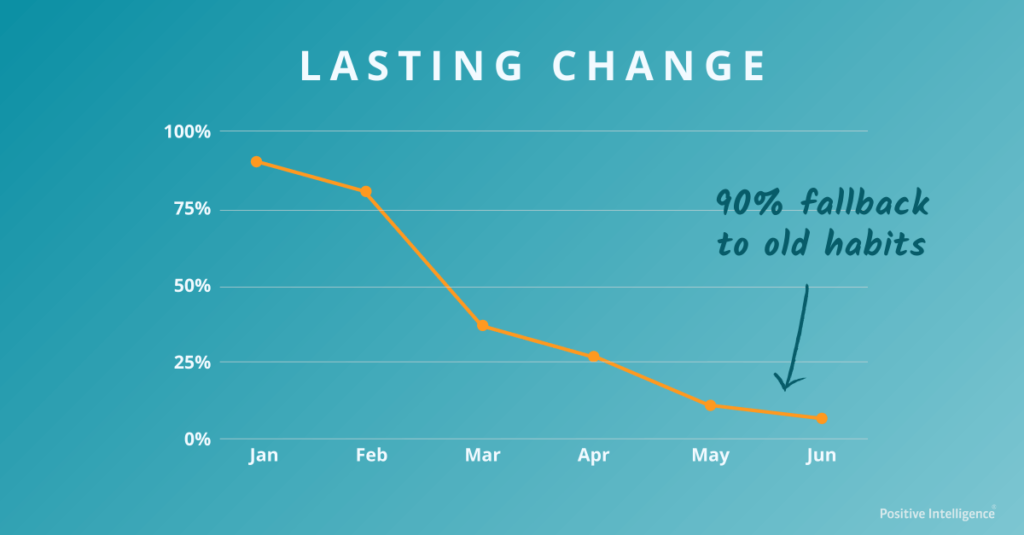Shirzad Chamine: How to create positive change that lasts

We’ve all experienced it — the euphoria, optimism, and excitement for transformative change, at the end of a “life-changing” seminar, book, or coaching session.
Could this finally be the transformed me, far happier and more capable than the old me?
And we’ve all experienced the discouraging deflation that ensued. Within months, only a trace of the new insight and inspiration was still with us. We mostly reverted to our old familiar self.

For years I’ve been in passionate pursuit of first figuring out why our attempts at positive change so consistently fizzle. And how to create positive change that lasts.
Starting with my Stanford lectures on the topic, and with a massive body of research, which has incorporated 500,000 participants, I believe we now have the answer to both.
There are 3 primary reasons why positive change initiatives fizzle:
1. We treat the symptoms rather than the root cause.
John is having trouble relating to his coworkers and told that he’s not collaborative or empathic enough. He is sent to a workshop that teaches him active listening skills. He learns to repeat back what he has heard, and mimic the body language of the other, to stay connected and tuned in. At first everyone is encouraged as they see the shift in behavior. John is trying hard.
Six months later, John is sitting across from a colleague, weary of this cumbersome technique that feels so artificial. He doesn’t “feel” empathy with the other. Instead, his strong inner judge voice, which was never exposed or weakened in the workshop, is busy judging the colleague as unworthy of trust or care.
The judge voice wins in the end, since the judge lives at the root level. Active listening techniques were just treating the symptoms. The workshop just planted a tree in inhospitable desert soil. It was destined to die.
2. We generate insights rather than build muscles.
Our bad habits live in our minds in the form of neural pathways, or mental muscles, that automatically generate our old responses. You don’t fight muscle with insight. You need to fight muscle with muscle.
No book, 2-day workshop, or coaching session can possibly build up enough muscle strength for the new way to counter the old way. At best these things generate insight and inspiration to behave in a new way.
True transformation requires 20% insight generation, 80% muscle building. You’d need to build systematic support for daily repetition of the new way for an extended period of time. This would convert the insights into neural pathways or mental muscles that form the new habits. In other words, new mental muscles to fight the old.
Most of our attempts at change stop at insight. Once we notice we’ve reverted back to the old behavior, we go in search of another book, another workshop, another false promise of transformation based on insight alone. And we become cynical about whether sustained change is even possible.
3. We lack a common operating system.
Mastery in anything requires constant and steady repetition. The problem is that we never get to do that because we’re trying to change too many things, and we don’t have a common operating system to unify those efforts. We get spread too thin.
So we end up chasing the 7 habits of effective people, the 6 ways to sell better, the 11 secrets of a happy marriage, the 9 principles of good parenting, the 5 steps to greater happiness, and the 3 ways to reduce stress. If we’re lucky, we remember and follow a nugget from each of these, and experience a tiny incremental benefit.
We don’t have enough time in the day to improve so many things when each uses a separate framework, lacking a common operating system to unify the effort.
As a former engineer, I used to be enthralled by the elegant power of operating systems. Prior to the advent of an operating system, we used a stand-alone calculator to just calculate, a typewriter to just type, a calendar to just schedule, etc.
With the advent of an operating system, you could just use one hardware device capable of running these three applications plus hundreds of other applications. A massive and radical 100-to-1 simplification occurred.
Inspired by this, I asked myself years ago “what if we could create an operating system for personal and professional development to radically simplify coaching, training, and development?”
To devise such an operating system, we needed to do a massive factor analysis on the root-level factors that determine our thoughts, emotions, and reactions.
What is factor analysis?
It’s an attempt to discover the fewest number of independent factors that together account for a huge number of variations in outcome. For example, there are thousands of colors in nature. But if you do factor analysis on them, you’ll discover that there are really only 3 color factors — Red, Green, and Blue. These 3 factors recombine to result in thousands of outcome variations. That realization enables massive simplification. As an artist, you’d now just need a palette of 3 colors, not hundreds, to paint any canvas.
Similarly, there are a thousand ways that we humans sabotage our own happiness, cause our own stress, derail our own performance, and fall short of our true potential. When we did factor analysis on the negative root-level dynamics of the mind, we discovered there were only 10 factors responsible for self-sabotage.
We called these the 10 Saboteurs. They are the Avoider, Controller, Hyper-Achiever, Hyper-Rational, Hyper-Vigilant, Judge, Pleaser, Restless, Stickler, and Victim. We are all afflicted with a few Saboteurs. ALL of our stress, upset, and other negative emotions are manufactured by our own Saboteurs. No positive change effort will be sustained unless it exposes and weakens our root-level Saboteurs.
On the positive end, while there are tens of emotional intelligence and leadership competencies and other personality characteristics associated with success and happiness, our research revealed only 5 root level positive factors. Only 5! We called these the 5 Sage Powers: Empathize, Explore, Innovate, Navigate, and Activate.
These findings result in a dramatic simplification of training, development, and coaching. We finally have the ability to create positive change that lasts — individually and collectively. The core operating system enables us to treat the issues at the root level rather than symptoms, as the Saboteurs and Sage Powers are at the root level.
And we’re able to focus on muscle building rather than just insight, as there are only a few core muscles to boost, and we know exactly how to boost them. We’re also more motivated to boost these few core muscles because we can immediately see benefits in multiple personal and professional applications, not just one.
Back to our friend John who took a short-lived workshop to learn to become more collaborative. Here’s how our approach would now be different:
Instead of singling out John as the problem employee, the team leader runs a very different team meeting. Ahead of the team meeting, everyone does the 5-minute Saboteur Assessment. The simple premise guiding the discussion is:
- We ALL are afflicted by Saboteurs that undermine both our effectiveness and happiness. Mine are X and Y. What are yours?
- Any time we’re reacting with negative emotions, such as upset, stress, blame, shame, etc., we’re hijacked by our Saboteurs and need to shift.
- There’s a simple 10-second technique, called a “PQ Rep,” to shift brain activation from the negative Saboteurs to positive Sage. Anyone in the team is empowered to stop the negative contagion and invite everyone to do a few PQ Reps to shift to the positive.
- Once the shift to positive brain activation occurs, regardless of what the issue is, it can best be handled through one of the 5 Sage Powers: Empathize, Explore, Innovate, Navigate, or Activate.
Suddenly, positive change is much more likely to be sustained. John is not feeling singled out. We’ve normalized the fact that we ALL self-sabotage, and we ALL can learn to improve. The shared common operating system enables the team to hold every member accountable for the new behavior since it is so easy to detect the negative emotions and prevent the typical negativity contagion. The positive shift can so easily be engineered with 10-second PQ Reps to shift brain activation and unleash the 5 Sage Powers.
The transformative impact of the operating system is in how it powers a hundred applications ranging from reducing stress and feeling happier in your job, to managing conflict, selling more persuasively, becoming more resilient in facing setbacks, collaborating more creatively in teams, saving your marriage from the Saboteur-to-Saboteur rot it has fallen into or shifting from being a micromanaging parent to an empowering one.
Every emotional intelligence competency, leadership competency, relationship mastery, soft skills, and growth mindset application is powered by this one operating system since it is based on root-level factor analysis.
Consider the case of Mary, a VP of quality assurance in a Fortune 100 company. The first application of this operating system for her was to learn to intercept her Controller Saboteur at work, so she could delegate and empower more.
The key Sage powers she grew in the process were Empathize and Explore. A few weeks into this practice, her teenage son came home from high school, sharing his not-so-great grades. 30 seconds into tearing into her son the way she usually did, Mary stopped.
Suddenly she could clearly see how her Controller Saboteur was triggering her son’s Avoider Saboteur, causing him to withdraw further and further from her.
She shifted her brain activation with a few PQ Reps, Empathized with how much pain and shame his son already felt, and Explored the deeper reasons why he had fallen behind, and how she could help. Mary reported that the Sage-to-Sage conversation that followed felt like a renewed relationship after a few years of painful distance.
Within months, this simple operating system was helping Mary be a better parent, be happier in her marriage, feel less stressed, sell and persuade better, be a more creative problem-solver, and be a more inspiring and empowering leader.
And since the benefits kept coming, she kept practicing the simple principles of intercepting her negative Saboteurs, shifting her brain activation, and using one of the 5 Sage Powers. The muscles kept growing.
If you’re working on growing yourself or others, I urge you to use the freely available tools of this operating system to accelerate and sustain that positive change.
The world is in urgent need of all of us to quiet the darker forces within ourselves and fuel our brilliant Sages. There is no problem in our personal lives, our teams, or our world that can’t be overcome with the wisdom and goodness of our Sages. How can you boost your own Sage today? How can you inspire others to do the same?
(Try the 5-minute Saboteur Assessment. Please share the gift of this article with others.)
This article first appeared on the Positive Intelligence blog.
Related Resources
Shirzad Chamine: Why mental fitness is the X-factor
Realistic ways for CEOs to improve their mental health
Reset your mind with clarity, confidence and creativity
Category: Work / Life Balance

